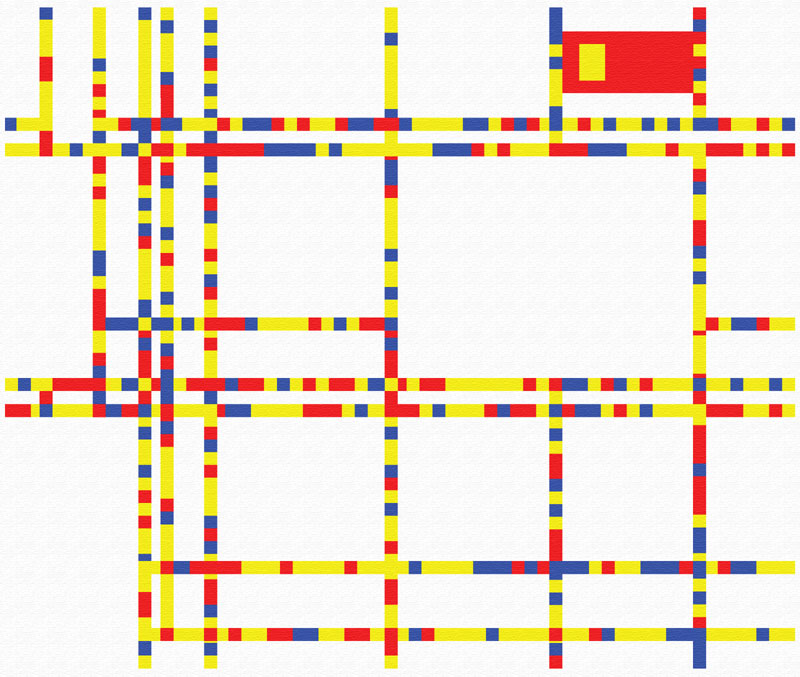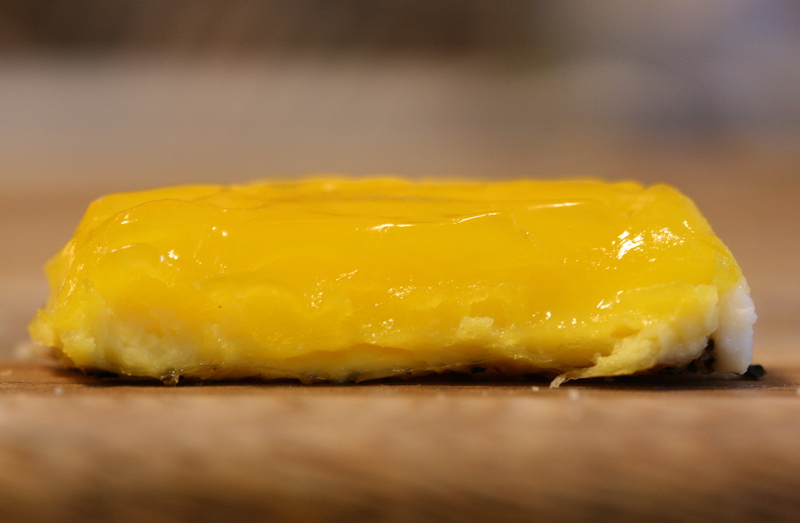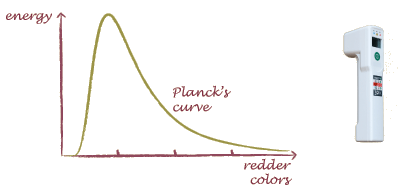Eggs Mondrian

Black, gray, and three primary colors. No pinks, purples, or greens. No subtle hues applied to the canvas. Mondrian set himself the challenge of creating art with a limited pallet and without recourse to the forms of nature. The juxtaposed elements of his paintings — the geometrical forms, the primary colors — provide scant material for stirring memories. A much different task than that faced by Monet, who broke with history and the studio, going outdoors to imprint nature on canvas. Small regions of colors merge in Monet’s paintings to form the impressions of light of nature’s scenery.
And so it is with eggs. Scrambled, the white and the yolk combine in the frying pan creating rich flavors. On their own they pose a challenge. The white has little flavor and the yolk is one of the few alkali food ingredients, a novelty that does not always please. Could the fried egg ever compete with the scrambled?

In 2002 The Guardian newspaper published a recipe for fried eggs, where the yolk and the white were separately cooked. It was penned by Heston Blumenthal, chef and owner of the The Fat Duck, one of around sixty restaurants to hold the coveted three star rating from the oldest restaurant guide, Le Guide Michelin. His egg recipe was the first molecular gastronomy recipe I ever read. I was unaware of this trend of injecting science into gastronomy, giving cooks more control over their art. I had even experienced the tasting menu at Clio in Boston, but failed to see the larger movement. In Blumenthal’s recipe, the egg yolk is a thick gel, almost like a mayonnaise, and the whites a soft custard. But reproducing that came only after many failures and some new tricks.
Blumenthal attributes the recipe to Bernard Loiseau, but the recipe does not match the one given in The Perfectionist, Chelminski’s portrait of french haute cuisine through Loiseau’s life. I suspect the Fat Duck master may have modified it a little. The recipe is part of a tradition that seems to trace back to Loiseau’s mentor, Fernand Point. Point, who serves as inspiration for the affable chef Gusteau in Pixar’s animated movie Ratatouille, would test his apprentices by asking them to fry an egg. With just a fat, salt, and pepper to create a dish, technique is paramount.

Fried eggs are easily overcooked. Adding to the challenge, the white and the yolk overcook at different temperatures, so, at first, it seems impossible to ever get it right. The egg white will cook first, going from clear to white as it heats up. When the temperature reaches 65°C (149°F) the whites are done and by 80°C (176°F) they are rubbery. The yolk starts out a thick liquid, gels up into a bright yellow cream at 65°C (149°F) before turning into a crumbly aggregate by 75°C (167°F). All this changes thanks to how the proteins in the egg tangle themselves.

What these three-star chefs can do by intuition one may be able to approximate with the help of an instant read thermometer. With the thermometer I was able to get timings for Blumenthal’s recipe that may serve as starting points for other ovens. The instant read thermometer works by detecting the infrared radiation given out by all objects. Gustav Kirchhoff worked out how the color and intensity of light given out by any object placed inside a special oven would only change with the temperature of the oven. How the object was painted and what it was made up of would not matter. By knowing how much red comes out one can use his law to deduce the temperature. The law turned out to be an approximation, but a very good one, and for most liquids in the kitchen the instant thermometer gives accurate readings. The thermometer can be used while melting sugar, to set your oven, while grilling, and for making Eggs Mondrian.
Recipe
In Eggs Mondrian (based on a recipe by Heston Blumenthal), the yolk and the whites are cooked separately in the oven. The butter is melted in the stove top with water controlling the temperature, but after that an oven is used for better control of the temperature. The plated egg is decorated with balsamic vinegar and served with mini sandwiches.
While living in New Mexico I acquired the taste for fried eggs smothered with green chile. The dish is spicy and not always suitable for a morning empty stomach, but it does make a great brunch dish. The mini sandwiches remind me of the New Mexican green chile and are great to dip into the yolk.

For the recipe you will need:
- 1⁄2 tablespoon (7g) of butter
- salt
- pepper
- one egg
- 1⁄2 teaspoon of balsamic vinegar
- hot pepper jam
- challah bread
Pre-heat the oven. The temperature setting should be 68°C (154°F), but most home ovens cannot be set this low, so set it as close as possible to 68°C. The times I provide are for an oven set to 93°C (200°F). Oil the inside of a metal, 10 cm (4 inch) diameter cookie cutter with non-stick spray and set aside. If you have two ovens warm the serving plate; otherwise wet a paper towel, spread it over the plate and heat for about 30 seconds in a microwave oven. Keep the plate in the oven until ready to use.
Make the mini sandwiches. Cut two half inch slices of challah bread. Spread a generous layer of pepper jam on one slice and layer the other slice over it. Place the sandwich on a cutting board and using a 4 cm (1.5 inch) diameter round cookie cutter cut-out a few mini sandwiches. Set aside for later.
Heat a frying pan on the stove top. Put into it the butter and a small amount of water (1 oz.). As Blumenthal notes, the water keeps the pan at 100°C (212°F) and prevents the butter from burning. Once the butter melts, remove from the heat. The stovetop step helps warm the pan.
Sprinkle salt and pepper on the pan. This will keep the seasoning on the bottom of the egg and give it a better appearance.
Remove an egg from the refrigerator and separate the egg white into a small bowl and gently place the egg yolk in the middle of the frying pan. Put the frying pan into the oven. As the oven is warmer than it should be, we will have to monitor the egg yolk carefully. Leave the yolk in the oven for 4 minutes, it should only be half done. If you have a thermometer, its temperature should read 60°C (140°F).
This step needs to be done quickly. Remove the frying pan from the oven. Center the cookie cutter around the yolk. The cookie cutter will help contain the egg white. Pour the egg white around the yolk while pressing down the cookie cutter. This can be done by one person! Hold the cookie cutter in place while the bottom layer of the white starts to develop a thin white film. This indicates that the white has set a bit and that you can release the pressure from the cookie cutter against the frying pan, but don’t remove the cookie cutter. The pouring and waiting should take 30 to 60 seconds.

Put the frying pan back into the oven. Cook for another two and one half minutes or until the temperature of the white reaches 65°C (149°F).
Remove the pan from the oven. Loosen the cookie cutter from the egg by running a blunt knife along the inside edge of the cookie cutter. Using a spatula, transfer the egg to the warm plate. With an dropper, sprinkle or streak the balsamic vinegar around the egg. Place a few of the sandwiches on the plate and serve.
Notes
- Maybe one day all homes will have convection ovens that can be set reliably to low temperatures. Until then one has to rely on timing to keep the temperatures of the egg in the right range. Being precise is difficult because so many things are different from kitchen to kitchen.
I have made the dish several times and of lately reproduced it solely on the timings, keeping the thermometer to set the oven temperature. If you make the dish without a thermometer you may have to adjust the timings a bit, so take notes.
I have an electric oven that I can set to 68°F. It takes around half an hour to be sure that the oven has stabilized at the right temperature. The heating element of the oven is on the bottom, so I place a dish with water on the lower shelf between it and the frying pan. The dish protects the frying pan from the direct heat radiation of the heating element. On one occasion, before using the water dish, the element warmed the frying pan from 68°C to 98°C. The dish also acts as a heat storage device, helping maintain a constant temperature every time I open the oven door.
When the oven is set at 68°C, the times for the different steps are much longer. Compare the timings:
| minutes | ||
|---|---|---|
| step | @ 68°C | @ 93°C |
| yolk in | 15 | 4 |
| white in | 8 | 2.5 |
At 68°C the timing does not have to be precise.
- There are many pepper jams in the market, many are bell pepper jams, some hot pepper ones, and very few made with New Mexico varieties of Capsicum annuum (these are the large chiles, like the Anaheim, NuMex Conquistador, or New Mexico number 6). When I run out of the New Mexico variety, I get the Earth & Vine Red Bell Pepper and Ancho Chili Jam, which can also be used for savory sandwiches (giving life to turkey breast, for example) or as a sauce for shrimp or chicken.
